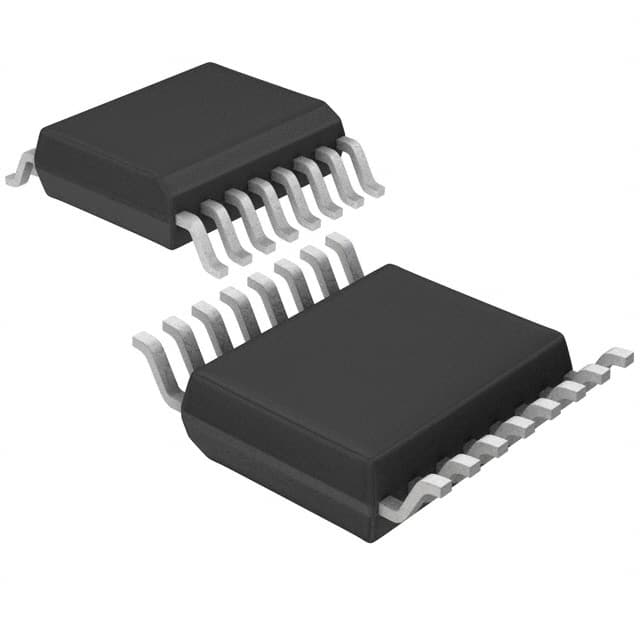MAX3221EIDB
Product Overview
- Category: Integrated Circuit
- Use: RS-232 Transceiver
- Characteristics: Low-power, 3.0V to 5.5V operation, ±15kV ESD protection, small package size
- Package: SSOP (Shrink Small Outline Package)
- Essence: The MAX3221EIDB is a low-power RS-232 transceiver designed for serial communication between devices operating at different voltage levels.
- Packaging/Quantity: The MAX3221EIDB is available in a SSOP package and is typically sold in reels of 2500 units.
Specifications
- Operating Voltage Range: 3.0V to 5.5V
- Data Rate: Up to 250kbps
- Number of Channels: 1
- Supply Current: 300µA (typical)
- ESD Protection: ±15kV (Human Body Model)
- Operating Temperature Range: -40°C to +85°C
Pin Configuration
The MAX3221EIDB has a total of 20 pins. The pin configuration is as follows:
Pin 1: VCC
Pin 2: GND
Pin 3: T1OUT
Pin 4: R1IN
Pin 5: R1OUT
Pin 6: T1IN
Pin 7: C1OUT
Pin 8: C1IN
Pin 9: SHDN
Pin 10: NC
Pin 11: NC
Pin 12: NC
Pin 13: NC
Pin 14: NC
Pin 15: NC
Pin 16: NC
Pin 17: NC
Pin 18: NC
Pin 19: NC
Pin 20: NC
Functional Features
- Low-power operation makes it suitable for battery-powered devices.
- Supports data rates up to 250kbps, allowing for fast serial communication.
- Provides ±15kV ESD protection, ensuring robustness against electrostatic discharges.
- Works with a wide operating voltage range of 3.0V to 5.5V, making it compatible with various systems.
Advantages and Disadvantages
Advantages: - Low power consumption extends battery life in portable devices. - Small package size saves board space. - Wide operating voltage range allows for compatibility with different systems. - ESD protection ensures reliability in harsh environments.
Disadvantages: - Limited to a single channel, limiting simultaneous communication with multiple devices. - Data rate limited to 250kbps, which may not be sufficient for certain applications requiring higher speeds.
Working Principles
The MAX3221EIDB is designed to convert logic-level signals between RS-232 and TTL/CMOS voltage levels. It uses internal charge pumps to generate the necessary voltage levels required by RS-232 communication. The transceiver operates by converting TTL/CMOS logic-level signals into RS-232 voltage levels for transmission and vice versa for reception.
Detailed Application Field Plans
The MAX3221EIDB is commonly used in various applications, including:
- Industrial automation systems
- Point-of-sale terminals
- Networking equipment
- Medical devices
- Consumer electronics
Detailed and Complete Alternative Models
Some alternative models that can be considered as alternatives to the MAX3221EIDB are:
- MAX3232EIDB: Similar to the MAX3221EIDB, but with two channels instead of one.
- MAX3241EIDB: Offers enhanced ESD protection and higher data rates compared to the MAX3221EIDB.
- MAX3237EIDB: Provides three channels and higher data rates, suitable for applications requiring multiple serial connections.
These alternative models offer different features and specifications, allowing users to choose the most suitable option based on their specific requirements.
In conclusion, the MAX3221EIDB is a low-power RS-232 transceiver that provides reliable serial communication between devices operating at different voltage levels. Its small package size, wide operating voltage range, and ESD protection make it suitable for various applications in industrial automation, networking, and consumer electronics. While it has some limitations, alternative models are available to address specific needs.
Senaraikan 10 soalan dan jawapan biasa yang berkaitan dengan aplikasi MAX3221EIDB dalam penyelesaian teknikal
Sure! Here are 10 common questions and answers related to the application of MAX3221EIDB:
Q1: What is the MAX3221EIDB? A1: The MAX3221EIDB is a low-power, RS-232 transceiver that operates at data rates up to 250kbps. It is commonly used for serial communication in technical solutions.
Q2: What is the operating voltage range of the MAX3221EIDB? A2: The MAX3221EIDB operates from a single power supply ranging from +3.0V to +5.5V.
Q3: Can the MAX3221EIDB be used for both transmitting and receiving data? A3: Yes, the MAX3221EIDB can be used for both transmitting and receiving data in RS-232 communication.
Q4: What is the maximum data rate supported by the MAX3221EIDB? A4: The MAX3221EIDB supports data rates up to 250kbps.
Q5: Does the MAX3221EIDB require external capacitors? A5: Yes, the MAX3221EIDB requires four external capacitors for proper operation.
Q6: Can the MAX3221EIDB be used with microcontrollers or other digital devices? A6: Yes, the MAX3221EIDB can be easily interfaced with microcontrollers, digital devices, and other ICs.
Q7: Is the MAX3221EIDB compatible with 3.3V logic levels? A7: Yes, the MAX3221EIDB is compatible with both 3.3V and 5V logic levels.
Q8: Can the MAX3221EIDB be used in industrial applications? A8: Yes, the MAX3221EIDB is suitable for industrial applications due to its robustness and ESD protection.
Q9: What is the package type of the MAX3221EIDB? A9: The MAX3221EIDB is available in a 20-pin SSOP package.
Q10: Are there any application notes or reference designs available for the MAX3221EIDB? A10: Yes, Maxim Integrated provides application notes and reference designs that can help with the implementation of the MAX3221EIDB in various technical solutions.
Please note that these answers are general and may vary depending on specific requirements and use cases. It is always recommended to refer to the datasheet and application notes provided by the manufacturer for detailed information.


